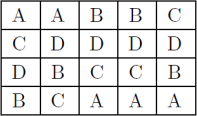MATH 1007 HOMEWORK 2
Hello, dear friend, you can consult us at any time if you have any questions, add WeChat: daixieit
MATH 1007 HOMEWORK 2
Problem 1: Problem 20.4 from textbook (p. 387)
20.4. Compare the value of m! with Stirling’s approximation for m! for m = 1, 2, 3, . . . , 10. For each of these values of m, compute by what percentage the approximation differs from the exact value.
Problem 2:
Compute ![]() and explicitly list each of the
and explicitly list each of the ![]() profiles with five voters in which three voters vote for candidate A and two voters vote for candidate B. You need only list the voters who vote for candidate A.
profiles with five voters in which three voters vote for candidate A and two voters vote for candidate B. You need only list the voters who vote for candidate A.
Problem 3: Problem 2.2 from textbook (pp. 39 – 40)
2.2. For the profile

who wins an election conducted via the
(a) plurality method?
(b) Borda count method?
(c) Hare method?
(d) Copeland method?
(e) antiplurality method?
(f) vote-for-two method?
Problem 4: Problem 2.10 (parts b, c, and d ONLY) from textbook (p. 41)
2.10. With 4 candidates, the Borda count method is the positional voting method that we denote P(3, 2, 1, 0).
(a) Consider instead the method P(4, 2, 1, 0). Show by example that this need not give the same outcome as the Borda count method.
(b) Consider now the method P(4, 3, 2, 1). Explain why this always gives the same outcome as the Borda count method.
(c) Consider the method P(8, 6, 4, 2). Explain why this always gives the same outcome as the Borda count method.
(d) Characterize those sequences (a, b, c, d) with the following property:
The positional voting method P(a, b, c, d) always selects the same winner as the Borda count method.
Problem 5: Problem 3.8 from textbook (pp. 59 – 60)
3.8. Answer each of the following questions with a response of the form “X must win” or “Y must lose”, or write “No conclusion can be drawn”.
(a) A social choice function satisfies the anti-Condorcet criterion and the profile is:

What can you conclude?
(b) A social choice function satisfies the neutrality criterion and candidate A wins in the “before” profile here:

What can you conclude about the “after” profile?
(c) A social choice function satisfies the Pareto criterion and the profile is:

What can you conclude?
(d) A social choice function satisfies the monotonicity criterion and candidate A loses in the “before” profile here:

What can you conclude about the “after” profile?
(e) A social choice function satisfies the independence criterion and candidate B wins and candidate C loses in the “before” profile here:

What can you conclude about the “after” profile?
Problem 6: Problem 4.4 (parts a and b ONLY) from textbook (pp. 77 – 78)
4.4. The anti-French method works as follows: From the profile, extract the two candidates who have the least and second least number of last-place votes. The winner of the anti-French method is the winner of a head-to-head contest — call it the run-off — between these two candidates. (If there is a tie for second least number of last-place votes, allow all these candidates to go on to the second round and conduct the run-off via the Copeland method.)
(a) Does the anti-French method satisfy the Condorcet criterion?
(b) Does the anti-French method satisfy the anti-Condorcet criterion?
Problem 7: Problem 5.6 from textbook (p. 93; no need to compare to exercise 5.5)
5.6. At Springfield High School, there is a student election for homecoming queen. There is a large slate of candidates, and preference ballots are used. After the ballots have been collected but before they have been revealed, the principal rules all but three of the candidate’s ineligible on academic grounds, leaving only Angela, Bertha, and Cassandra as permissible candidates. Rather than going to the trouble of calling a new election, the school president decides to implement the best-of-three method in this situation: If any one of Amy, Bertha, or Cassandra is preferred to the other two by a majority of the student body, then that candidate becomes homecoming queen. Otherwise, the election is declared to be a tie among these three girls. Does the best-of-three method satisfy the independence property?
2023-02-25